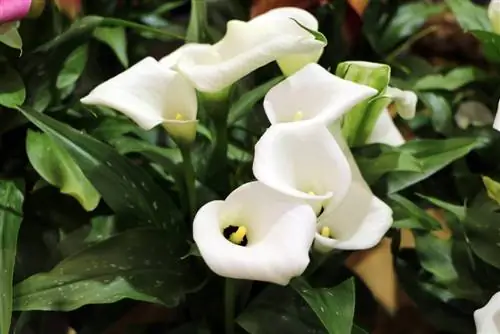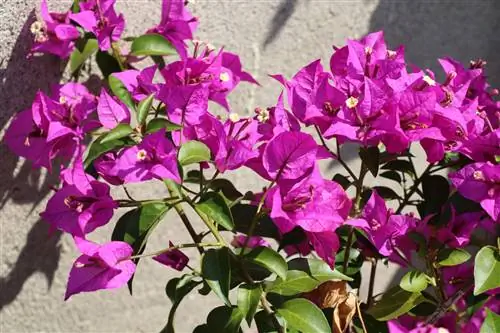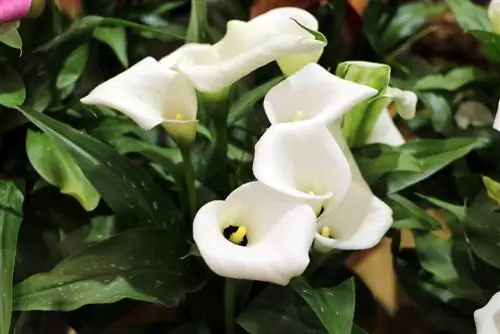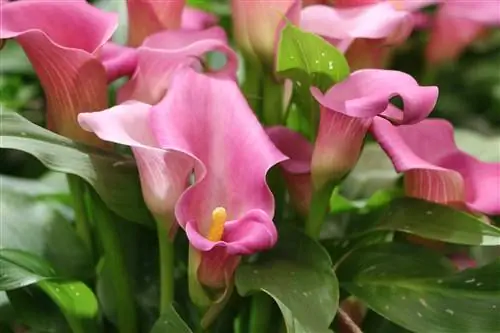- Author admin [email protected].
- Public 2023-12-17 03:39.
- Last modified 2025-01-24 12:45.
The calla with its elegant white flowers and expressive leaves has been used since historic times as a houseplant for elegant floral room decoration. Since then, the houseplant has multiplied its design talents: the well-known, winter-flowering indoor calla is available in several delicately colored cultivars - and it has gained a few summer-flowering “colleagues” whose flowers really add color to the house. Read below how the beautiful Zantedeschia are cared for and overwintered (and why the real Zantedeschia does not overwinter but is “oversummered”):
Profile
- The calla is considered one of the most elegant houseplants
- The indoor calla Zantedeschia aethiopica has been known to us for a long time
- It blooms in the local winter, a nice change in the dreary season
- Today not only in white, but also in delicate colors
- The attractive Zantedeschia belong to the arum family
- They form their own genus with eight Zantedeschia species
- All of which are cultivated in their respective homeland
- Some species have made it into our trade
- A real innovation and a benefit: these are summer-flowering species
- The flower color is much more colorful than their winter-pale relatives
Care
The indoor calla is a houseplant with specific requirements. Which she would like to see fulfilled quite extensively if the large-leaved and tall-stemmed beauty is to develop in perfect flawlessness. But it is possible to please a calla lily:
- Location: Bright, the calla is native to light-drenched South Africa
- The plant tolerates temperatures between 12 to 25 degrees Celsius
- German room temperatures are quite good during the growth phase
- White-flowering calla lilies like it cooler than colorful-flowering varieties
- There are times in the growth cycle when callas need different ambient temperatures (see below)
- At home, callas grow in swamp meadows that dry out every six months
- This location corresponds to the window seat without direct sun
- Avoid blazing midday sun and accumulating heat
- The location should be protected from the wind and free from drafts
- The indoor calla has no special requirements when it comes to the substrate
- Garden soil, loosened with sand and with a medium humus content
- Or normal potting soil, but please use sterile, freshly purchased quality soil
- Callas are quite defenseless against native pathogens in contaminated potting soil
- The Zantedeschia is also watered moderately in the vegetation phase from the end of February/beginning of March
- Fertilized with normal green plant fertilizer
- During the growth phase, mix liquid fertilizer into the irrigation water every two weeks
- Depending on the appearance/effect of the plant, half to full amount stated on the package
- Do not exceed the fertilizer concentration, callas react sensitively to the slightest over-fertilization
Tip:
“Swamp plant” and “moderate watering” don’t go together? However, even if the swamp does not dry out half the year like it does here, swamp plants do not have their roots in pure water. The only plants that can withstand this are the true aquatic plants, and the calla is not one of them.
Flower care in an upside down world of flowers
The elegant Zantedeschia are cultivated for their unique flowers, which still appear elegant even if they are not the usual white, but rather brightly colored.
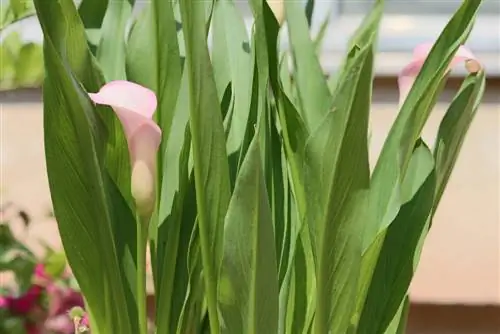
If you take it seriously, the “calla flowers” are not the least bit spectacular: the actual flowers are located inside the “large-leaved flowers”, on the yellow bulbs, and are as numerous as they are tiny. What we perceive as white, yellow, orange, wine red or black-purple flowers and appreciate because of their high decorative value are actually leaves; Bracts around the spadix.
These flowers appear on the most famous indoor calla with the botanical name Zantedeschia aethiopica from around January to April. Because they are actually (robust, fleshy) leaves, they last a very long time, three to eight weeks.
Since the Zantedeschia aethiopica blooms in a topsy-turvy world here (its flowering time is normally in the summer, just in the South African summer), it takes a little “persuasion” to get it to develop flower spadix and colored bracts:
- The plant should be kept in such a way that it experiences life cycles similar to those in Africa
- The swampy meadows of their African homeland dry out from May onwards
- So the Zantedeschia goes into hibernation from May and pulls in its leaves
- You can remove the Zantedeschia from the ground in May, store the tubers in a dry place and replant them in autumn
- You can also cultivate the calla lily
- It then needs great care during the main growing season in winter
- In late spring, summer (its winter) the calla is watered a little
- Scarce watering is enough to entice them to “go through” (without moving in, no hibernation)
- From mid/late September to December, the calla needs a stay at a cool 10 - 12 degrees to induce flowers
- During flower induction it is not fertilized and watered a little more but moderately
- Then it is placed in an environment with 13 to 15 degrees, bright (as bright as possible)
- From January onwards, in the warmer environment, she gets a lot more water
- As soon as the first buds “push”, the calla receives flowering plant fertilizer
- From this point until the end of flowering once a week, towards the end increasingly more sparingly
The indoor calla can also live through the summer rest outdoors when it is kept dry or almost dry and disturbs the rest. As soon as the thermometer shows 12 °C plus (even at night), the Zantedeschia can be placed in the garden, on the terrace or on the balcony. The amount of light, which is much higher than in living spaces, strengthens the plant, which is reflected, among other things, in the fact that it produces flowers more easily later in the year.
The outdoor location should be protected from the wind, on the wall of the house or in the protection of other plants. On hot days, the Zantedeschia enjoys showers from the spray bottle, which can completely replace watering during the break.
Planting and repotting
Usually indoor calla lilies are bought in pots, which are usually too small. The calla should therefore be planted or repotted as quickly as possible in a pot, in completely fresh soil (the soil in the sales pot is usually not of award-winning quality).
You can also plant Zantedeschia, which will spend the summer in the garden, in the bed. The time for this is when the soil has reached temperatures of at least 10 °C and is safely maintained, i.e. around mid-May in most regions.
If you are already an expert, you have purchased Zantedeschia tubers from the nursery. They are planted by burying them about 5 to 7 cm into the potting soil or garden soil and then covering them with soil.
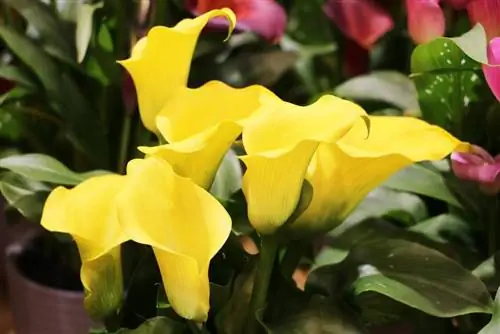
In autumn, Zantedeschia that have “oversummered” are repotted in the garden, namely into the pot in which they spend the cold season indoors. Otherwise, calla lilies should be repotted once a year because synthetic fertilizer concentrates such as green plant fertilizer and flowering plant fertilizer can never be dosed so precisely that s alts do not accumulate in the soil. The Zantedeschia reacts more sensitively than many other plants to such fertilizer residues and therefore needs fresh soil regularly. But not necessarily a larger pot every time; You only need it when the rhizomes hit the wall of the pot.
Calla plant sap, e.g. B. from trimming the rhizomes when repotting, should always end up on a surface that can be disposed of after work (old newspaper). Not only is it irritating (tip below), but it also causes stains on all sorts of materials.
Cutting
When the bract flower of the calla has completed its long lifespan, the leaves turn yellow, become dry and eventually fall off. It would be best for the plant if you wait until the overripe parts of the plant say goodbye on their own, because they are integrated into the plant metabolism until they are finally separated.
If you have a Zantedeschia in a place that is constantly in view, this can be visually disturbing, so the flower stem can also be cut away. If it is one of the first flowers of the season, removing the dead flower stem also has the advantage that the calla puts its energy into producing more flowers (and not into seed production).
After flowering (at the end of the growing season), some of the calla leaves usually turn yellow. These leaves can be cut away, as can all old and dried plant parts.
Species and varieties
The calla described here that blooms between January and April is called room calla or common calla and botanically Zantedeschia aethiopica. “Calla”, “beautiful”, is her name after the fabulously beautiful Greek goddess Calliope, because she was also said to be beautiful. It is called “Zantedeschia” after Giovanni Zantedeschi (Italian botanist), who discovered the calla lily in the 18th century. Discovered in the century and brought to Europe.
For some time now, in addition to the classic South African beauty, three other types of calla lilies have been available from (well-stocked specialist) retailers:
- Zantedeschia albomaculata, spotted calla, arrow-shaped silvery-white spotted leaves
- Zantedeschia elliottiana has a similar leaf shape and translucent white spots on the leaves
- Zantedeschia rehmannii has lanceolate leaves, pure green without markings
These Zantedeschia also come from Africa, but from areas with a lot of rain and constant daytime warmth in the winter there, in which they also bloom (in contrast to the Z. aethiopica, which in the South African summer and here in the winter bloom).
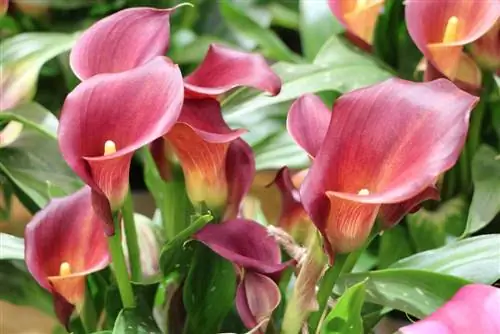
So these three species bloom in our summer, from June or July, and are cared for in a similar way to Zantedeschia aethiopica; However, taking into account the completely different life cycle, the time of rest here is in our winter.
Breed varieties with colored flowers are now available for all Zantedeschia species. Zantedeschia aethiopica shows itself in more delicate colors, light yellow, pink, flamingo. Zantedeschia albomaculata produces magnificent flowers with an orange-gold color gradient or a dark purple calyx base, Zantedeschia elliottiana and rehmannii “can do many colors”: white, orange, rose-red, dark purple.
The summer-flowering Zantedeschien are of course even better as garden or pot plants than the winter-flowering classic because they decorate the open-air stand with their flowers.
The newest varieties of calla lilies can stay in the garden and overwinter there:
- Zantedeschia aethiopica ‘Crowborough’: hardy calla lily with huge white flowers (from July) and lush foliage
- Zantedeschia aethiopica ‘Glencoe’ new and hardy like Crowborough, but more vigorous and stronger
- Both calla lilies should tolerate frost down to minus 20 degrees, which corresponds to USDA climate zone 6b, and initially fits the German WHZ 6-8
- Both cultivars are “hardy when they are still fresh” and therefore “particularly sensitive”
- You should e.g. B. cannot be planted in autumn like other perennials, but rather need the summer to take root
- A sheltered location is also recommended, but it should not be too hot or too dry
- The hardy calla plants are completely absorbed above ground in late autumn
- “The rest” (the root tubers) can be protected from dying when the temperature drops with some winter protection in the form of brushwood
- Buckets with the colorful new varieties can be kept dark over the winter after freezing (=moving in)
Propagate
Sowing is possible, but not common and not recommended: If you want to buy seeds, you will have to spend some time searching, even in specialist shops. It is not certain whether self-collected seeds will germinate. If they do, the young plant will need years until its first flowering.

It is better to grow young plants from rhizomes (Z. aethiopica) or root tubers (summer flowering species). They can be bought (exchanged); You can also try taking secondary tubers or rhizome pieces of your own plants and growing them. Whether Zantedeschia can be propagated by dividing the root tubers is controversial, so it seems to be a risk.
Conclusion
Sensitive people, small children and pets should treat Zantedeschiens carefully or be encouraged to do so. All parts of the plant are slightly poisonous; they cause severe irritation of the mucous membranes, possibly with the slightest contact with the plant sap. This is known from Zantedeschia aethiopica, so it can be assumed that it is the case with its conspecifics. When cooked, the leaves of Z. aethiopica are said to be edible, but this should only be of interest to very curious gourmets.

